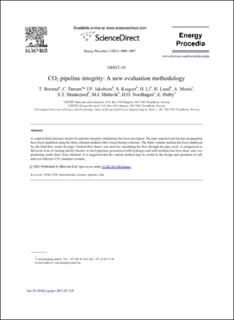| dc.contributor.author | Berstad, Torodd | |
| dc.contributor.author | Dørum, Cato | |
| dc.contributor.author | Jakobsen, Jana Poplsteinova | |
| dc.contributor.author | Kragset, Steinar | |
| dc.contributor.author | Li, Hailong | |
| dc.contributor.author | Lund, Halvor | |
| dc.contributor.author | Morin, Alexandre | |
| dc.contributor.author | Munkejord, Svend Tollak | |
| dc.contributor.author | Mølnvik, Mona Jacobsen | |
| dc.contributor.author | Nordhagen, Håkon Ottar | |
| dc.contributor.author | Østby, Erling | |
| dc.date.accessioned | 2020-12-15T13:28:53Z | |
| dc.date.available | 2020-12-15T13:28:53Z | |
| dc.date.created | 2011-11-30T09:44:50Z | |
| dc.date.issued | 2011 | |
| dc.identifier.citation | Energy Procedia. 2011, 4 3000-3007. | en_US |
| dc.identifier.issn | 1876-6102 | |
| dc.identifier.uri | https://hdl.handle.net/11250/2719584 | |
| dc.description.abstract | A coupled fluid-structure model for pipeline integrity simulations has been developed. The pipe material and fracture propagation have been modelled using the finite-element method with a local fracture criterion. The finite-volume method has been employed for the fluid flow inside the pipe. Choked-flow theory was used for calculating the flow through the pipe crack. A comparison to full-scale tests of running ductile fracture in steel pipelines pressurized with hydrogen and with methane has been done, and very promising results have been obtained. It is suggested that the current method may be useful in the design and operation of safe and cost-effective CO2 transport systems. | en_US |
| dc.language.iso | eng | en_US |
| dc.publisher | Elsevier | en_US |
| dc.rights | Attribution-NonCommercial-NoDerivatives 4.0 Internasjonal | * |
| dc.rights.uri | http://creativecommons.org/licenses/by-nc-nd/4.0/deed.no | * |
| dc.subject | Leak | en_US |
| dc.subject | Pipeline | en_US |
| dc.subject | Fracture | en_US |
| dc.subject | Fluid-structure | en_US |
| dc.subject | CFD | en_US |
| dc.subject | FEM | en_US |
| dc.title | CO2 pipeline integrity: A new evaluation methodology | en_US |
| dc.type | Peer reviewed | en_US |
| dc.type | Journal article | en_US |
| dc.description.version | publishedVersion | en_US |
| dc.rights.holder | © 2011 the authors. Published by Elsevier Ltd. Open access under CC BY-NC-ND license. | en_US |
| dc.source.pagenumber | 3000-3007 | en_US |
| dc.source.volume | 4 | en_US |
| dc.source.journal | Energy Procedia | en_US |
| dc.identifier.doi | 10.1016/j.egypro.2011.02.210 | |
| dc.identifier.cristin | 862793 | |
| dc.relation.project | Norges forskningsråd: 193816 | en_US |
| dc.relation.project | Egen institusjon: 16X89331 | en_US |
| cristin.unitcode | 7401,80,6,6 | |
| cristin.unitcode | 7401,80,4,5 | |
| cristin.unitcode | 7548,60,0,0 | |
| cristin.unitcode | 7548,16,0,0 | |
| cristin.unitcode | 7401,80,6,0 | |
| cristin.unitname | Material- og konstruksjonsmekanikk | |
| cristin.unitname | Materialprosessering og modellering | |
| cristin.unitname | Gassteknologi | |
| cristin.unitname | Energiprosesser | |
| cristin.unitname | Materialer og nanoteknologi | |
| cristin.ispublished | true | |
| cristin.fulltext | original | |
| cristin.qualitycode | 1 | |

